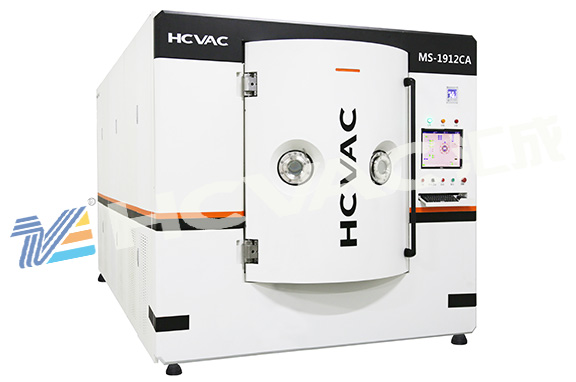In the vacuum of the magnetron sputtering vacuum coating machine, the high-energy particles bombard the surface of the material, so that the atoms get enough energy to escape the surface and reach the substrate to condense and form a film. Compared with real hair coating, sputter coating is suitable for all (including high melting point) materials, and has the advantages of strong adhesion, controllable composition, and easy large-scale production.

1. Magnetron sputtering vacuum coating machine diode sputtering
A direct current high voltage is added between the target and the substrate, the gas (generally Ar2) between the plates is ionized, and the high-speed charged ions bombard the surface of the target with sputtering coating technology. To maintain self-sustained discharge, the discharge gas pressure is generally as high as 10 Pa at a normal sputtering spacing with a distance of several centimeters between the two polar plates, which is detrimental to sputtering efficiency and film quality. Therefore, DC sputtering mostly adopts non-self-sustained discharge, that is, quadrupole sputtering with the addition of thermionic emitter and auxiliary anode, which can make sputtering under low pressure of 10-1 to 10-2 Pa.
Advantage: simple structure
Disadvantages: Only metal materials with good conductivity can be sputtered, and the sputtering efficiency is low
2. Magnetron sputtering vacuum coating machine RF sputtering
The RF power supply is used instead of the DC power supply, and a high-frequency voltage is applied between the target and the substrate. During sputtering, the target will produce a self-bias effect (that is, the target will automatically be in a negative potential state), so that the sputtering of the insulating target can be maintained. . A commonly used frequency is around 13.56 MHz.
Advantages: All materials can be sputtered, including conductors and insulators, with high sputtering efficiency and mass production
Disadvantage: RF power supply has certain radiation problems
3. Magnetron sputtering vacuum coating machine magnetron sputtering
The working principle of magnetron sputtering is that under the action of electric field E, electrons collide with argon atoms in the process of flying to the substrate, ionizing them to produce Ar positive ions and new electrons; the new electrons fly to the substrate, Ar ions are accelerated to the cathode target under the action of the electric field, and bombard the target surface with high energy, so that the target sputters. In sputtering particles, neutral target atoms or molecules are deposited on the substrate to form a thin film, and the generated secondary electrons are subjected to electric and magnetic fields, resulting in a drift in the direction indicated by E (electric field) × B (magnetic field), abbreviated as E×B drifts, and its trajectory approximates a cycloid. If it is a toroidal magnetic field, the electrons move in a circular motion on the target surface in the form of an approximate cycloid, and their motion paths are not only very long, but also bound in the plasma region close to the target surface, and ionize a large amount of Ar to bombard the target, resulting in high deposition rates. As the number of collisions increases, the energy of the secondary electrons is exhausted, gradually moving away from the target surface, and finally deposited on the substrate under the action of the electric field E. Since the energy of the electrons is very low, the energy transferred to the substrate is very small, resulting in a low temperature rise of the substrate. Magnetron sputtering is a collision process between incident particles and a target. The incident particle undergoes a complex scattering process in the target, collides with the target atom, transfers part of the momentum to the target atom, and the target atom collides with other target atoms to form a cascade process. During this cascade, target atoms near certain surfaces gain sufficient momentum to move outward, leaving the target to be sputtered.
Advantages: high film formation rate, low substrate temperature, good film adhesion, large area coating can be achieved
Disadvantages: The target material consumption is uneven, and the target material of magnetic material cannot be used
4.
Magnetron sputtering vacuum coating machine reactive sputtering
The development of modern surface engineering increasingly requires the use of various compound films, and reactive magnetron sputtering technology is one of the main ways to deposit compound films. To deposit compound films with multiple components, the target material made of compound materials can be used for sputtering deposition, or when sputtering pure metal or alloy targets, a certain reactive gas, such as oxygen and nitrogen, can be introduced to react and deposit compound films. This is called reactive sputtering. Usually pure metal targets and reactive gases are easy to obtain high purity, so reactive sputtering is widely used to deposit compound films.
advantage:
(1) Reaction The target material (single-element target or multi-element target) and reactive gas (oxygen, nitrogen, hydrocarbon, etc.) used in magnetron sputtering are of high purity, which is conducive to the preparation of high-purity compound films.
(2) By adjusting the process parameters in reactive magnetron sputtering, stoichiometric or non-stoichiometric compound films can be prepared, and the film properties can be regulated by adjusting the composition of the film.
(3) During the reactive magnetron sputtering deposition process, the temperature of the substrate is relatively small, and the substrate is usually not required to be heated at a high temperature during the film forming process, so there are fewer restrictions on the substrate material.
(4) Reactive magnetron sputtering is suitable for the preparation of large-area uniform thin films, and can realize the industrialized production of single-machine annual output of millions of square meters of coating.
Disadvantages: prone to target poisoning, anode disappearance and other problems



